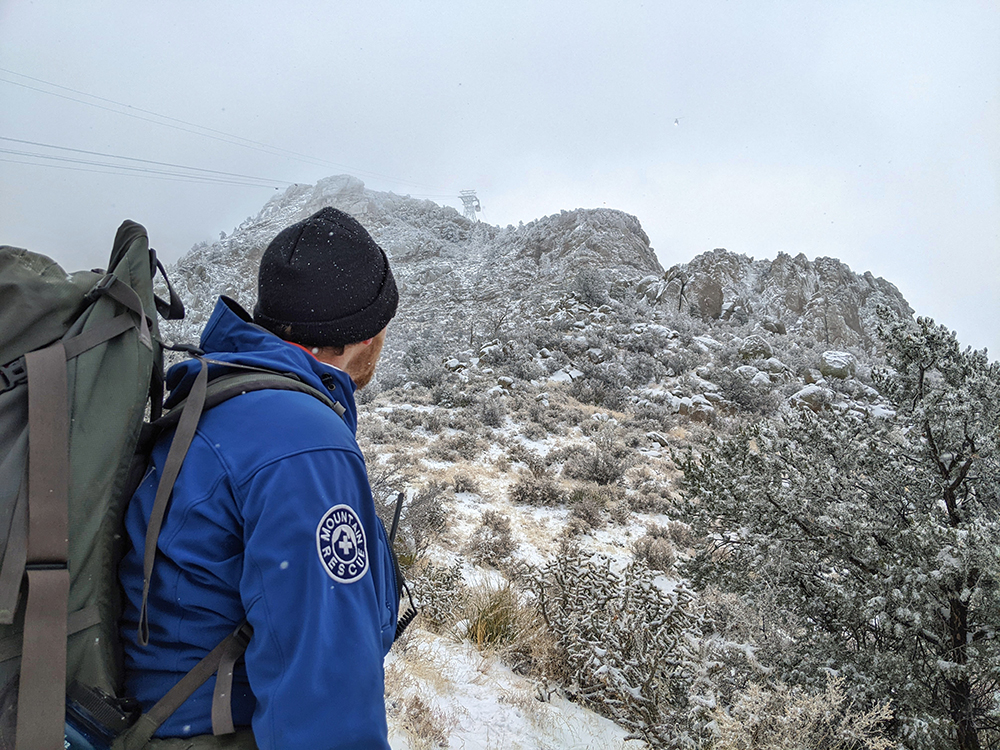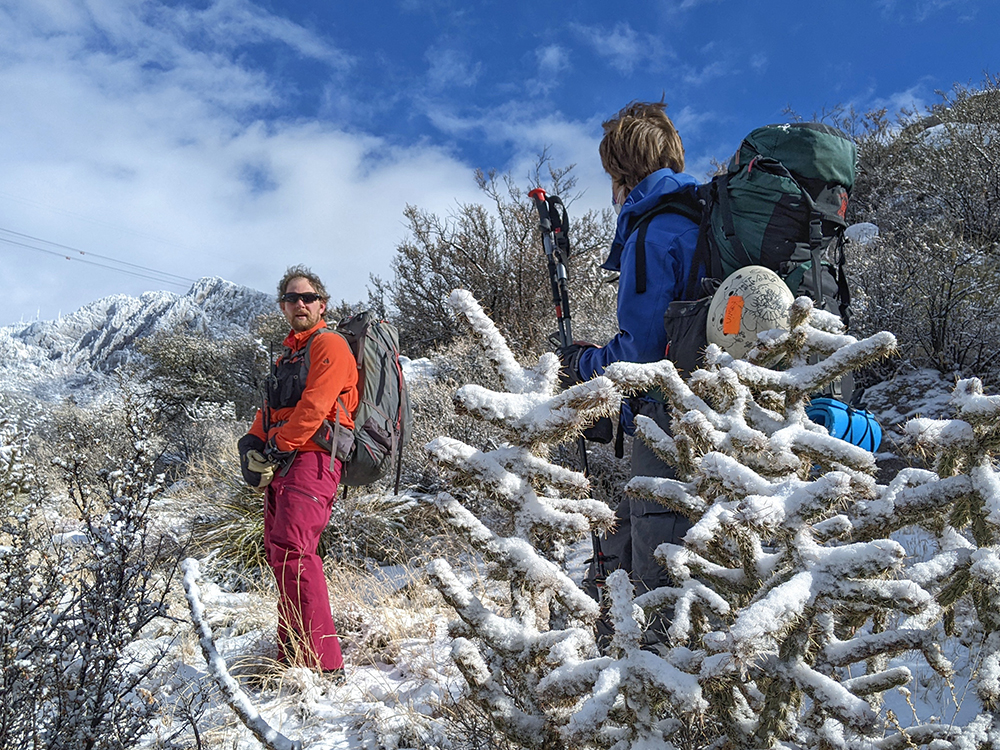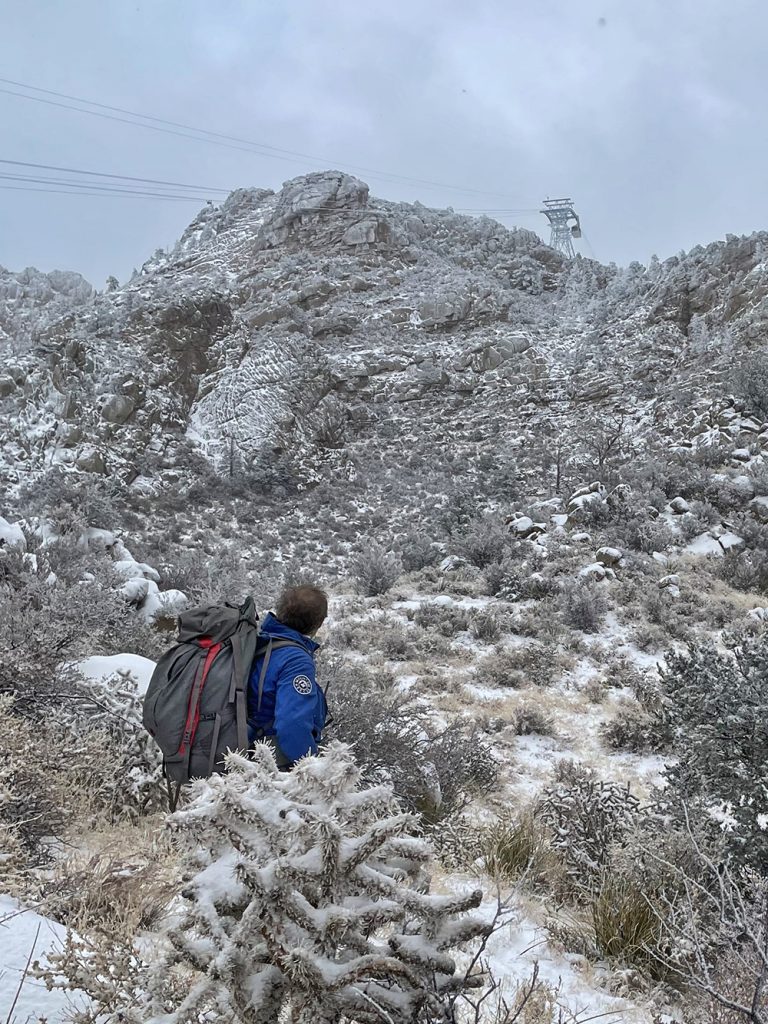
Hours after ringing in the new year, emergency personnel and volunteer rescuers across the state, including seven Sandia employees and one retiree, received a call about an incident on the Sandia Peak Aerial Tramway. Twenty-one people, mostly employees of TEN 3, the restaurant at the top of the tramway, had been trapped in tram cars during a storm since 9 the previous night.
The Sandia employees and retiree are members of the Albuquerque Mountain Rescue Council or Cibola Search and Rescue teams that assisted in the rescue on New Year’s Day. They joined other search and rescue teams, law enforcement, first responders, tram owners and employees during the sometimes treacherous and harrowing rescue.
Mechanical designer Shane Ruzinsky and chemical engineer Craig Tenney, both members of the Albuquerque Mountain Rescue Council, recounted their experiences from the snowstorms on the rugged mountain with Lab News.
Lab News: How were you notified about the incident?
Shane: I was in Ohio visiting family when I received the call. When search and rescue is requested to respond to an emergency, an incident commander from the state will contact each team in the area. This call goes out simultaneously to the teams’ leadership. The first person to answer the call is then designated as the mission manager. This was my role for this incident.
I was able to do this remotely through texts, calls and work on my laptop. Our initial task was to enter the field and provide emergency supplies, like food, water, blankets and clothing, to the people who were trapped. Our job was to keep them comfortable, safe and in good health while the tram employees were working on repairs and other contingency plans. We did not know initially that we would need to evacuate the tram cars, but our members were prepared for that.
After checking weather reports, I paged out our team of nearly 50 active members with necessary information and a brief description of the situation. As the mission manager, I ensured that they had the correct equipment and were ready for the weather and broadcasted any updates I received.
Craig was one of the first responders that morning and led the first team into the field. He’s a technical leader on our team who is qualified in all our specialty skills.

Craig: Four of us assembled as Team One. Shortly after 5 a.m., we loaded up with materials and traveled to Tram Tower Two, an almost three-hour, off-trail hike. Our first objective was simply to make it to the tower, which is not trivial, even in the summer and especially challenging given the conditions.
We were joined by one of the owners and employees of the tram, who were the experts for getting up the tower and into the tram car. The team started handing out supplies, and the people seemed much happier with our arrival. With over 20 people in the tram car, you think it would be warm, but it was quite chilly from hanging in the wind during a winter storm. To add to that, due to all those people breathing, it was slowly raining condensation from the ceiling.
Plans to evacuate were developed after we got into the tram car. Once we passed out materials, cloud cover was still very low, so the helicopter didn’t seem like an option. We needed to figure out how to evacuate 21 people from the tram through rugged terrain in winter conditions, keeping in mind that they were dressed for work at the restaurant. The tram owner started making lists of boot sizes so more teams could bring up necessary clothing and footwear for these people to hike out.
The plan would have been to lower people to the ground, escort them to the cliff band, lower further down by rope, then escort them down the mountain using multiple rescuers. It would take a lot of support to pull off that plan safely.

Fortunately, as we were making all these plans, the weather gods smiled upon us, the clouds lifted and the sun came out for a while. We were able to lower people out of the tram car one by one. They were received by rescuers below and escorted to a landing zone that had been set up along the rocky ridge where Tram Tower Two sits. They were loaded into a Bernalillo County Sheriff’s Office helicopter and flown to the parking lot of the tram terminal. The helicopter started doing laps, taking two to four people at a time, as we lowered them out of the tram car as quickly and as safely as possible. Fortunately, just as the cloud cover was coming back in with another storm, we were able to get all the employees onto the helicopter and out. Then the weather turned bad again.
Rescuers, including two additional people from the tram company that had arrived after us, and one lone employee in the other tram car were still on the mountain. My team sheltered as best we could in the storm, while tram personnel worked to slowly move the other tram car down to Tram Tower Two. They could only move it an inch or two at a time, so the entire procedure was going to take an hour or two.
At least two of the people the tram company had brought in were certified mountain guides, and all had mountaineering experience, so they had the resources and training to safely get the one remaining employee out of the second tram car. To minimize risk, my team and a Bernalillo County Fire Department rescue specialist, who had originally flown in on the helicopter, began hiking out. This required rappelling off the ridge where Tram Tower Two sits, then two hours of hiking down to the lower tram terminal. Ironically, the weather cleared as we were halfway down, so the six people who were still at Tram Tower Two got a helicopter ride, and we finished our hike down to the tram terminal.
Lab News: What did the teams learn from this experience?
Craig: I attended an after-action review for the mission, along with representatives from Bernalillo County Fire Department, Bernalillo County Sheriff’s Office, New Mexico State Police, tram owners, tram employees and the incident commander. During this review, we talked about ways to be more prepared in the future. The only big learning point was that when these incidents occur and rely on multiagency responses, it’s important that all players have situational awareness and coordinate their communication well. Overall, it went amazingly smoothly.
Lab News: How often is Albuquerque Mountain Rescue called for rescue operations?
Craig: Historically, 40 to 50 times per year. The distribution is sporadic but tends to be around holidays. We were happy to pay a favor to the tram company. They have been immensely supportive of us during other missions we get in the Sandia Mountains. They give us free rides up and down the tram to save us hours of hiking and travel. Their situation was unfortunate, but we were glad to help out and maybe start to even the scales a bit.
Shane: It’s very rare in a mountain rescue scenario to rescue 21 people. This is pretty unheard of and will certainly go down in the history of our team and New Mexico Search and Rescue for being such an unusual situation. Given the circumstances and the number of people stranded, we’re very happy that it turned out as well as it did.